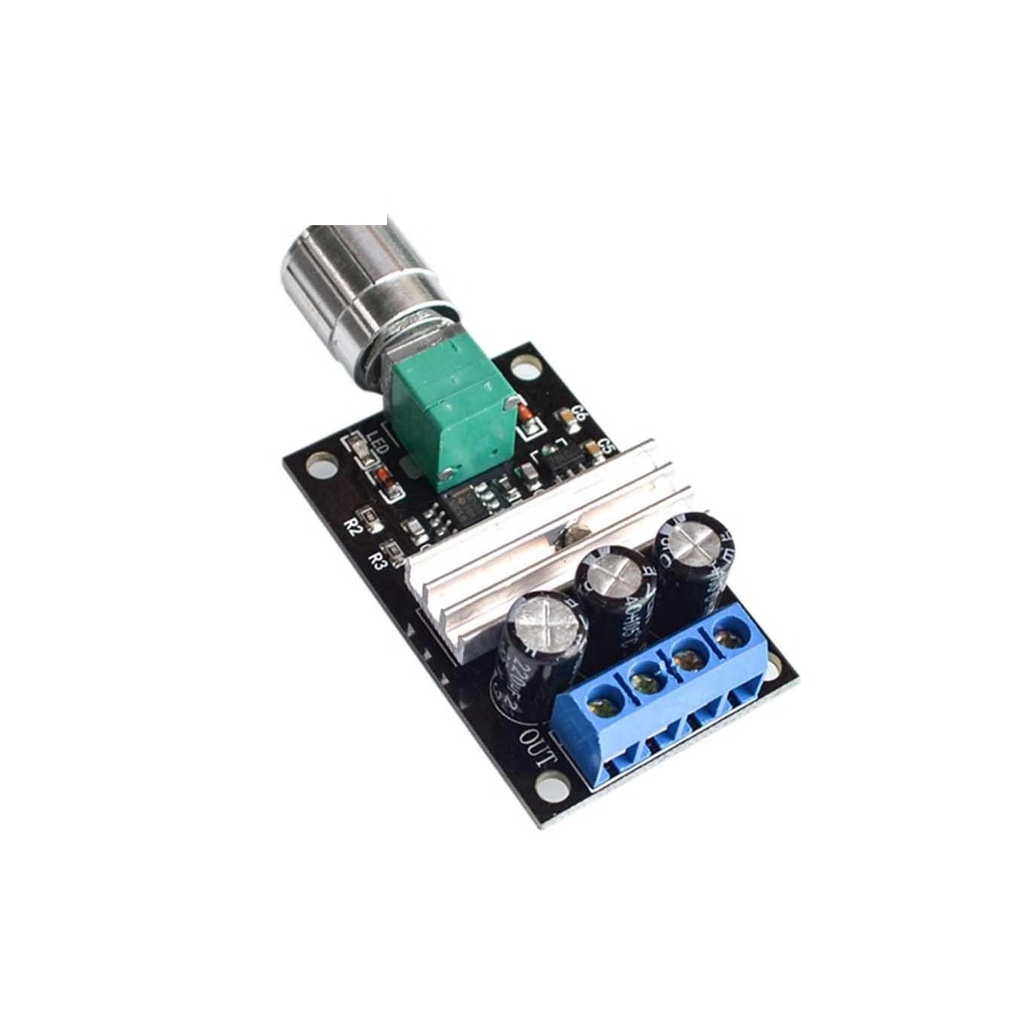Features:
- Smooth and precise control of DC motor speed and direction using PWM signals
- Provides up to 3A continuous current to the motor or DC load
- Supports 6V to 28V DC input voltage
- Maximum output power: 80W
- Adjustable duty cycle from 5% to 100%
- Direction of motor can be changed via a simple control input
- Compact design with clear wiring instructions
Principle of Work:
The controller adjusts the average voltage supplied to the motor by changing the duty cycle of the PWM signal. A higher duty cycle results in higher motor speed. A direction control input allows changing motor rotation direction: High input spins the motor in one direction, and Low input reverses it.
Pinout of the Module:

- Motor+: Motor Positive Terminal
- Motor-: Motor Negative Terminal
- Power+: DC 6V – 28V Input
- Power-: Ground
Applications:
- Motor speed control for robotics and automation
- Fan and pump speed regulation
- Industrial machinery (e.g., conveyor belts)
- RC vehicles and drones
- Power tools control
- Model trains and hobby electronics
- Lighting and home appliance control
Circuit Example:
Steps to control a 12V motor:
- Connect 12V battery positive to Power+ of the module.
- Connect 12V battery negative to Power-.
- Connect motor positive lead to Motor+.
- Connect motor negative lead to Motor-.
- Adjust the potentiometer to change motor speed via PWM.

Library:
No library required
Code:
No code required
Technical Details:
- Voltage Range: DC 6V – 28V
- Current Range: Up to 3A continuous
- Switch Function: None
- Speed Range: 0–100%
- Dimensions: 65 x 30 x 15 mm
- Weight: 25 g
Resources:
- More Info (if applicable)
Comparisons:
Motor Driver PWM Module vs. Arduino with Motor Driver:
Advantages of PWM Module:
- Standalone—no microcontroller or programming required
- Compact and easy to use
- Wide voltage range (6V–28V)
- 3A continuous current suitable for many small to mid-sized motors
- Cost-effective
Advantages of Arduino with Motor Driver:
- Flexible, programmable control using software
- Supports multiple devices and sensors
- Enables advanced automation and logic
- Can provide higher output for larger motors
Choose the PWM module for simple, low-cost motor control projects. Use Arduino + motor driver for programmable and more complex systems.
Features:
- Smooth and precise control of DC motor speed and direction using PWM signals
- Provides up to 3A continuous current to the motor or DC load
- Supports 6V to 28V DC input voltage
- Maximum output power: 80W
- Adjustable duty cycle from 5% to 100%
- Direction of motor can be changed via a simple control input
- Compact design with clear wiring instructions
Principle of Work:
The controller adjusts the average voltage supplied to the motor by changing the duty cycle of the PWM signal. A higher duty cycle results in higher motor speed. A direction control input allows changing motor rotation direction: High input spins the motor in one direction, and Low input reverses it.
Pinout of the Module:

- Motor+: Motor Positive Terminal
- Motor-: Motor Negative Terminal
- Power+: DC 6V – 28V Input
- Power-: Ground
Applications:
- Motor speed control for robotics and automation
- Fan and pump speed regulation
- Industrial machinery (e.g., conveyor belts)
- RC vehicles and drones
- Power tools control
- Model trains and hobby electronics
- Lighting and home appliance control
Circuit Example:
Steps to control a 12V motor:
- Connect 12V battery positive to Power+ of the module.
- Connect 12V battery negative to Power-.
- Connect motor positive lead to Motor+.
- Connect motor negative lead to Motor-.
- Adjust the potentiometer to change motor speed via PWM.

Library:
No library required
Code:
No code required
Technical Details:
- Voltage Range: DC 6V – 28V
- Current Range: Up to 3A continuous
- Switch Function: None
- Speed Range: 0–100%
- Dimensions: 65 x 30 x 15 mm
- Weight: 25 g
Resources:
- More Info (if applicable)
Comparisons:
Motor Driver PWM Module vs. Arduino with Motor Driver:
Advantages of PWM Module:
- Standalone—no microcontroller or programming required
- Compact and easy to use
- Wide voltage range (6V–28V)
- 3A continuous current suitable for many small to mid-sized motors
- Cost-effective
Advantages of Arduino with Motor Driver:
- Flexible, programmable control using software
- Supports multiple devices and sensors
- Enables advanced automation and logic
- Can provide higher output for larger motors
Choose the PWM module for simple, low-cost motor control projects. Use Arduino + motor driver for programmable and more complex systems.


